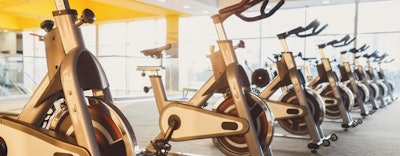
Today's group cycling classes are high-energy events that feature thumping music and motivational instructors. The stationary bikes used in these classes are expertly designed technological marvels that offer end users a bevy of metrics and the kind of ride they would experience on the open road. Here are a few of the main features to consider as you select the right setup for your facility.
Price vs. quality
If you've ever experienced a cycling class, you know that the cycles themselves are subjected to a beating. They will be ridden hard and sweat upon. Given that connected group cycles range in price from $1,000 to $5,000, it may be tempting to focus solely on price and sacrifice a modicum of quality. However, this is one purchase that demands investment in quality equipment that's built to last.
RELATED: Find more solutions for your facility in the Buyers Guide
Connectivity, metrics and platform
Today's group cycles are built around some sophisticated technology. Most of these units can track heart rate, cadence, watts, calories burned, speed and distance. Depending on the manufacturer and the type of platform the company uses, those metrics are made available to the instructor, allowing them to monitor a group or individual's performance and prompt participants based on that data. You'll want to inquire as to the intricacies of the manufacturer's software platform and the extent to which the system is interoperable with third-party apps, such as Strava and MapMyRide, for tracking workouts. For more information on cloud-connected cardio equipment, see our feature on page 30.
Adjustable
Because people with a wide range of body types will be using the group cycles in your facility, it's important to ensure that the units you select are easily adjustable. From seat and handle bar height to resistance, users should be able to adjust quickly prior to and during a class, and without the use of tools.
RELATED: Why Investment in Connected Cardio Equipment Makes Sense
Resistance and maintenance
There are two main types of resistance found in high-end group cycles: direct contact and magnetic. Direct contact works the same as brakes on a road bike, with pads that tighten on the flywheel to create friction and thus more resistance when pedaling. Because this type of resistance involves actual friction between parts, it will require more maintenance in the form of pad replacement. While more expensive, magnetic resistance is touchless and shouldn't see as much wear and tear as direct-contact units, resulting in lower maintenance costs.
RELATED: PRODUCT SPOTLIGHT 2019: Cardio Equipment
Software upgrades
Because most enterprise-grade cardio equipment today comes with an integrated computer, you might be concerned about installing software updates and dealing with multiple individual personal computers on your club's cardio floor. Fear not, for most manufacturers are able to automatically install regular software updates, and the computer on board each piece of equipment will likely notify manufacturers of problems that might arise during daily use, while also alerting technicians when regularly scheduled maintenance is due. It's important to ask your cycle provider how it handles both mechanical and digital/software maintenance.
This article originally appeared in the January | February 2019 issue of Athletic Business with the title "Purchasing Guide: Features to consider when shopping for group cycles" Athletic Business is a free magazine for professionals in the athletic, fitness and recreation industry. Click here to subscribe.
































